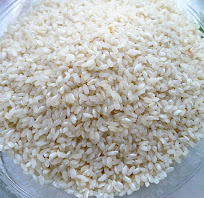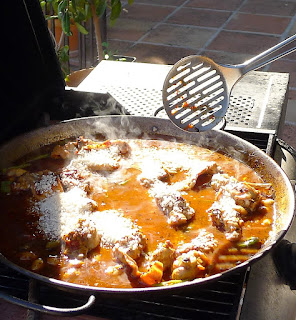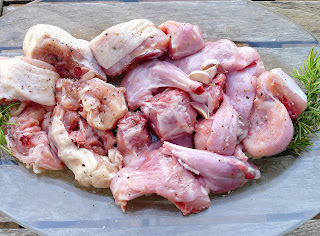 |
Practice makes perfect.
|
So, "what’s the secret to making great paella?" I asked Santos, then the manager of D.O.Arroz de Valencia, who drove me around through the shimmering rice paddies of the Albufera (Valencia). His answer was not “it’s the quality of the rice,” or “sofrito is the secret,” or “you need a good caldo.” No, his reply was, “Practice every Sunday.”
Here’s the secret: your paella will get better and better the more you make it.
I didn’t follow his advice. I make paella rarely, for cooking classes, for friends and family visiting from abroad or when I’m a guest in someone else’s home while travelling in the U.S.
Over the years, I’ve strayed from the original, traditional recipe quite a lot. For one thing, to adapt to stove-top cooking, I got myself a small-sized paella pan with a no-stick surface. That pretty much means no socarrat, the crusty rice on the bottom of the pan. I tend to the touristy version, loaded with chicken and shrimp, gaudily garnished with strips of red pimiento and green peas. (Paella maestro, Norberto Jorge, calls such paellas “overwrought.”) Also, taking a tip from chefs I’ve talked to, I’ve become a real stickler for making caldo, flavorful stock, with shrimp heads and shells.
But authentic Valencia paella doesn’t require any of those things. No seafood. No sausage. No garnishes. And, surprisingly, no stock, just water to cook the rice. And practice.
The return of my big paella pan, 15 years after a friend borrowed it, motivated me to resume paella practice. So, here we go.
 |
Ben has never made paella before. So, he's cooking, I'm coaching and taking the photos. First, level the pan. Add olive oil and heat.
|
The pan.
We used a 46-cm (18-inch) pan for a paella with 2 cups of rice, about 2 ½ pounds chicken and rabbit pieces. That serves four, five or six. We cooked it on a gas grill, where it didn’t quite fit. We needed to level the pan, using a rod balanced on bricks. Because there was a stiff breeze, we didn’t get full heat from the three gas burners and we sometimes needed to close the grill cover to maintain temperature. Having a kitchen nearby, I was able to bring the water to a boil on the stove instead of in the paella pan, which would have taken longer. Moderating the heat, however, may have saved us from burning the rice on the bottom! We got a perfectly crispy socarrat.
In Valencia, both the pan and the food cooked in it are called “paella”. Elsewhere in Spain, folks might call the pan a paellera. It is a wide, shallow, two-handled pan that allows rice to be cooked quickly over a fast-burning wood fire. It should be shallow enough so that, initially, liquid covers all the rice. That way the rice cooks evenly and all the grains soak up the flavors.
Traditional paella pans are made of rolled and polished steel (acero pulido). (There are also paella pans with flat bottoms especially made for induction cooktops; enameled pans; stainless steel pans, and pans with no-stick surfaces.)
Fill a new pan with water and bring it to a boil. Drain and wash the pan with soapy water. Dry it thoroughly and it’s ready to use.
After using the pan, allow it to soak in soapy water for 10 minutes to loosen encrusted bits. Use a stiff brush or metal scratcher-pad to clean the pan, inside and out. Dry the pan completely using paper towels or cloth. Rub it inside and out with a light coating of oil. Store the pan upright, preferably wrapped in paper (such as newspaper), in a dry place.
A paella pan used every week, like a wok or cast iron skillet, gradually builds up a seasoned surface. If used infrequently, you will need to wash off the film of oil before using the pan. Dry it well.
 |
Use round-grain rice for paella.
|
The rice.
Use Spanish medium-grain round rice, such as Senia, Bahía or Bomba. (Some have denominación de origen, such as Valencia and Calasparra.) The great virtue of Spanish rice is that it’s a terrific conductor of flavor, soaking up the savory juices with which the rice cooks—chicken, rabbit, the herbal essence of snails, fresh vegetables, the heady scent of saffron. Long-grain “American,” “pilaf,” or converted rice is not a substitute for paella making.
Do not wash the rice before cooking. Once rice and liquid are in the pan and distributed evenly, do not stir the rice again. Stirring releases the rice starch and makes a gummy paella.
 |
| Flat beans, fat beans, tomato, olive oil. |
Other ingredients.
It’s all about the rice. All other ingredients are to flavor the rice. Start with olive oil. Sauté chicken and rabbit, cut in small pieces. (If rabbit isn’t on your shopping list, use all chicken.) In Valencia, wide, flat green beans, called ferradura, are used with fat butter beans, garrofón. The fresh green beans can cook in the paella, but butter beans should be precooked (or use canned or frozen ones).
Create a sofrito with tomato, garlic and pimentón (paprika). Hint: if you’re cooking over gas, use smoked pimentón to add a hint of smoke; if cooking over a naturally smoky wood fire, use ordinary pimentón (not smoked.)
A sprig of rosemary adds a characteristic herbal note. (Snails, often included in Valencia paella, are a natural herbal package.) Pull the rosemary out of the liquid after a couple of minutes so the flavor doesn’t overpower the rice. Use real saffron, in threads. Crush it between your fingers and sprinkle it into the bubbling liquid in the pan and stir to mix it in. (Saffron won’t give a brilliant yellow color; for that many home cooks use artificial yellow coloring. Just sayin’.)

1. Allow 15-20 minutes to slowly brown the pieces of chicken and rabbit in olive oil.
2. Push the pieces of meat to the outer edge and add the green beans and butter beans to the oil. Continue sautéeing.
3. Stir the pimentón into the oil. Have ready the grated tomatoes, so the pimentón doesn't burn.
4. Add the tomatoes with crushed garlic. For the sofrito, allow the tomatoes to reduce—stirring frequently—until reduced to a dark, jammy consistency. This will take about
10 minutes.
 |
Add water or stock to continue cooking the meats.
|
5. Now it’s time to add the liquid—water or stock. Add sprigs of rosemary. Add salt. Bring the liquid to a boil. (Remove the rosemary.) Keep the liquid bubbling on medium-high heat until reduced. If you started with 5 ½ cups, you want to reduce the liquid to about 4 ½ cups, 15-20 minutes. This step creates flavor—the meats and sofrito flavor the liquid. That's why you don't need stock. Crush the saffron with your fingers and sprinkle it into the liquid.
 |
Add rice to bubbling liquid.
|
6, On a hot fire, with the liquid bubbling, add the rice. Stir to distribute the rice and other ingredients. Cook 8 minutes.
 |
Reduce heat to finish cooking the rice.
|
7. As the rice absorbs liquid, the grains begin to show on the surface. Now reduce the heat to low and continue cooking until all the liquid is absorbed and the rice is al dente-tender, 10 minutes. If you scrape up some rice from the bottom, you should notice it’s beginning to crust—the socarrat.
 |
Paella is done. Remove it from the heat and let it rest.
|
8. When the rice is cooked and liquid is absorbed, remove the paella from the heat. Allow the paella to set
10 minutes, covered with a cloth or sheet of foil, before serving.
 |
Paella is ready to serve! Not bad for being out-of-practice!
|
Rustic Valencia Paella
Paella Valenciana
Serves 4-5.
½ rabbit (about 1 ¼ pounds), cut in 2-3-inch pieces
1 pound chicken, cut in 2-3-inch pieces
Salt
Freshly ground black pepper
1/3 cup olive oil
½ cup giant lima beans or cooked butter beans
4 ounces romano green beans, cut in 2-inch lengths
1 teaspoon pimentón (paprika)
2 cloves garlic, crushed
2 cups grated fresh tomatoes (about 3 large tomatoes)
5 ½ cups water
12 cooked snails in their shells (optional)
Pinch of saffron threads, crushed
2 sprigs rosemary
2 cups round-grain Valencia rice
 |
| Chicken and rabbit are cut in small pieces. |
Sprinkle the rabbit and chicken pieces with salt and pepper and allow them to come to room temperature.
Heat the oil in a paella pan over moderately-high heat. Brown the pieces of rabbit and chicken slowly, 15-20 minutes. Push the meats to the sides of the pan and add the lima beans or butter beans and the romano beans. Sauté the beans 3 minutes and push them to the sides, leaving the center free.
Stir the pimentón into the center of the pan. Immediately add the crushed garlic and the grated tomatoes. Spread the tomatoes out and continue cooking slowly, stirring frequently, until the tomatoes are reduced and beginning to brown in places, about 10 minutes.
Add the water. Add 1 teaspoon of salt, the crushed saffron and the sprigs of rosemary. (If using snails, add them now.) Stir to distribute the chicken, rabbit and beans in the pan. Bring the water to a boil over high heat. Remove and discard the rosemary. Cook on moderately-high heat 15-20 minutes, allowing the water to reduce by about a quarter.
Taste the liquid in the pan and add salt if necessary. Stir in the rice. Use a wooden paddle to distribute the rice evenly.
Cook the rice on high heat for 8 minutes. Carefully, grasp the handles of the pan, using a heat protector, and shake the pan briskly to redistribute the rice and other ingredients. Do not stir the rice.
Lower the heat. Continue cooking the rice on low until all the liquid is absorbed and a crust is beginning to form on the bottom, 10 minutes.
Remove the pan from the heat and allow to set 10 minutes before serving.
 |
Scoop up some of the crusty rice from the bottom of the pan to serve with the paella.
|
 |
Crusty brown bits are the socarrat.
|
More versions of paella:
Rice dishes that are not paella:
